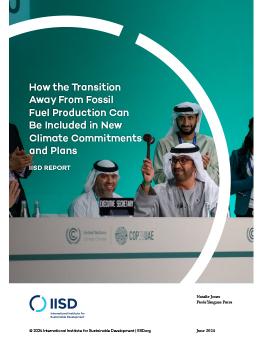
How the Transition Away From Fossil Fuel Production Can Be Included in New Climate Commitments and Plans
Governments are due to submit their third nationally determined contributions (NDCs) in 2025. These will be the first since the landmark agreement at COP 28 to transition away from fossil fuels. This report analyzes how fossil fuel production has appeared in NDCs to date and suggests ways for countries to reflect the transition away from fossil fuel production in their third-generation NDCs.
-
New NDCs and LT-LEDS must tackle not only the use of fossil fuels, but also fossil fuel production in a way that is aligned with the #COP28 global stocktake agreement to transition away from fossil fuels in a just, orderly, and equitable manner.
-
One third of the 20 biggest fossil fuel producing countries do not mention transition of the fossil fuel sector in their NDCs, and more than half have not submitted an LT-LEDS or do not mention fossil fuels in their LT-LEDS.
-
Countries can include several elements in their third-generation NDCs and LT-LEDS to reflect the #COP28 agreement to transition away from fossil fuels, including targets, pathways, policies and measures to wind down fossil fuel production, and policies and measures for just transition and economic diversification.
At COP 28, countries reached a landmark agreement to transition away from fossil fuels. Ahead of COP 30 in 2025, countries are expected to submit their third generation of NDCs. These should reflect the COP 28 agreement to transition away from fossil fuels. Meeting the Paris Agreement goals while avoiding an unnecessarily abrupt and disruptive transition away from fossil fuels requires that governments plan for a managed phase-out of fossil fuel production. Countries have a timely opportunity to reflect this in their next-generation NDCs as well as their long-term low-emissions development strategies (LT-LEDS).
This report analyzes the last round of NDCs from the top 20 biggest fossil-fuel-producing countries: Algeria, Australia, Brazil, Canada, China, Germany, India, Indonesia, Iran, Iraq, Kuwait, Norway, Poland, Qatar, Russia, Saudi Arabia, South Africa, Turkey, United Arab Emirates, and the United States. Together, these account for 93% of global coal production, 80% of oil, and 77% of gas.
A third of the NDCs make no mention of fossil fuel production, while six stated an intention to continue or increase production. Only one, the EU, representing coal producers Germany and Poland, mentioned a pathway to decrease production.
The report identifies five elements governments can include in NDCs and LT-LEDS to reflect the outcome of the global stocktake at COP 28:
- information on national fossil fuel production, future production plans, reserves, and support
- targets and pathways to wind down fossil fuel production. This could be in the form of a commitment to reduce or phase out fossil fuel production by a target date
- policies and measures to disincentivize or constrain fossil fuel production, for example, moratoriums on development and production and export caps, reform of production subsidies, and increased taxes on extraction
- policies and measures to support workers and communities in the transition and diversify the economy away from fossil fuel production
- information related to equity and international support and cooperation
Participating experts
You might also be interested in
Fossil Fuel Production, Renewable Energy, and Subsidy Reform in Nationally Determined Contributions 3.0
This policy brief provides an analysis of the critical benchmarks and recommendations necessary for aligning nationally determined contributions (NDCs) with the 1.5 °C target.
March 2025 | Carbon Minefields Oil and Gas Exploration Monitor
Last month, a total of 22 oil and gas exploration licences were awarded across six countries, with an estimated volume of discovered resources of 45.4 million barrels of oil and 10.4 billion cubic feet of gas.
February 2025 | Carbon Minefields Oil and Gas Exploration Monitor
In January 2025, 77 oil and gas exploration licences were awarded in seven different countries, with Norway leading in terms of embodied emissions.
January 2025 | Carbon Minefields Oil and Gas Exploration Monitor
Last month, a total of 78 oil and gas exploration licences were awarded in two countries. The United States had the largest volume of embodied emissions in the licences it awarded.